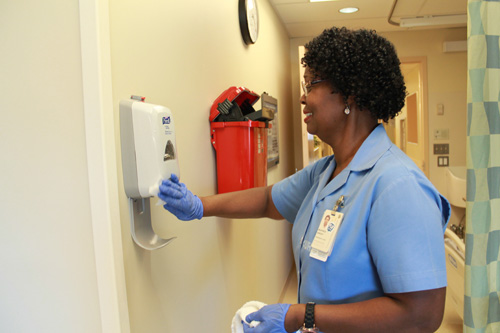
Beatrice Harvey, a housekeeper at Toronto General Hospital, says the new Clorox wipes are “very durable and effective” and also help “get the jobs done faster.” (Photo: IPAC)
For Beatrice Harvey, it's a simple, caring approach.
"We talk. They share their stories with us. Sometimes we know more about their lives than the nurses," Beatrice, a housekeeper, says with a laugh as she recalls her experience with some of the patients on 7A, a multi-organ transplant unit at Toronto General Hospital.
Beatrice has worked at TGH for more than 30 years.
"I treat everyone one the same way," she says. "I try to make patients feel more like family and not like strangers. It makes them more receptive that way."
New Clorox wipe
Environmental Service staff like Beatrice work diligently across UHN. They are part of the front line team ensuring the environment is cleaned and safe for patients when they're visiting the hospital, or being cared for on the unit. Like other programs, their role is vital to the maintaining patient safety and improving the patient experience.
"It starts here and since housekeeping was my first role in the hospital it's still in the forefront of my mind," says Giancarlo Irwin, a ward clerk at Toronto Western Hospital Emergency Department. "Patient safety means everything. If you can't keep patients safe, we can't provide any service."
Unit 7A and the TWH Emergency Department are just two of the patient areas at UHN that have been using the new Clorox wipe. Starting next month, all in-patient units at TGH, TWH and Princess Margaret Cancer Centre will convert to using Clorox as the primary cleaner and disinfectant for patient rooms and shared equipment.
Will help reduce
C. difficile
The new wipe uses sodium hypochlorite, commonly known as bleach, to kill microbes including
C. difficile.
"The switch will help us reduce
C. difficile burden and infections, which can have a significant and sometime serious negative affect on our patients," says Dr. Camille Lemieux, Associate Director at Infection Prevention & Control, or IPAC. "We're always looking to improve patient safety, and looking at best practices meant considering options for new ways of cleaning and for a new disinfectant to always kill
C. difficile in the environment."
Kathy Bates, the Manager of the TWH Emergency Department, says patient safety is of paramount importance.
Improved patient safety
"Anything we can do to implement strategies to improve the safety of staff and patients is always welcomed," she says.
As she begins her work day, Beatrice collects the bucket of Clorox wipes from her cart and brings them with her into the patient room.
"It's about organizing yourself," she says. "This is how I learned to clean. With the new wipes you carry everything with you, you take what you need."
Beatrice wipes down the stripped patient bed, the rails and side table. She'll return once it's dried to remove any residue buildup. "This wipe is very durable and effective on tough soiled areas. All we have to do is pull the wipe and then dispose. It gets the jobs done faster."
Smell fades over time
Some units have seen a shift in how they think about patient safety since they started using the Clorox wipes to watch for contact time, to let it sit and dry. And we're conscious of not leaning on it because it can stain clothing."
According to TWH Emergency Department nurse Laura McBride, there was anxiety before the Clorox wipes were brought onto the floor and some nurses were scared of the bleach at first.
"We thought that it might be a lot stronger and eat through the gloves" says Laura. "Now, our unit is a lot cleaner, and it smells cleaner".
To units switching over to the new wipes, Laura has some advice.
"The smell will not be as strong once you use it for a while," she says. "Let it dry to let it work properly."
Adds Giancarlo Irwin: "We keep an eye on the residue and manage it. The switch over has been fairly painless and the smell will fade."
For Beatrice, she knows it's about doing the best thing for our patients.
"At the start, the smell was very strong," she says. "Now, when we clean, we know it's there but it's not as bad."
